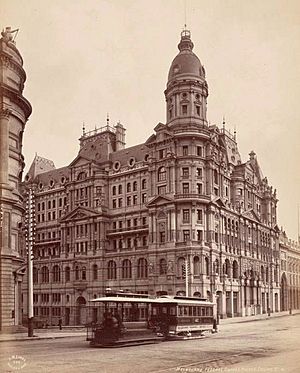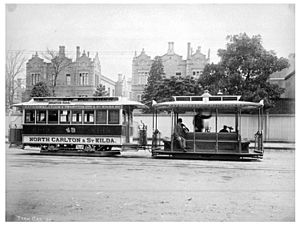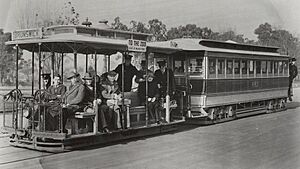Melbourne cable tramway system facts for kids

The Melbourne cable tramway system was a special type of public transport. It used cable cars to move people around. This system ran in Melbourne, Victoria, Australia, from 1885 to 1940.
The very first line opened on 11 November 1885. It went from Spencer Street to Bridge Road in Richmond. By 1891, all the planned lines were built. The last one was a short line from Windsor to St Kilda Esplanade. It opened on 17 October 1891.
At its peak, the system had about 75 kilometres (47 miles) of double tracks. It had 1,200 cars and trailers. There were 15 routes that spread out from the centre of Melbourne. This made it one of the largest cable car systems in the world. It was similar in size to systems in San Francisco and Chicago.
Most of the network was built by the Melbourne Tramway Trust. This group included people from the 12 local councils that the trams served. The Trust bought land, laid the tracks, and built the special buildings called cable winding houses.
The Melbourne Tramway & Omnibus Company (MTOC) ran the trams. They operated the services from 1885 to 1916. This was under a special 30-year agreement with the Victorian Government. Francis Boardman Clapp, an American who moved to Australia, started MTOC. He bought the rights to the cable system ideas from Andrew Hallidie. George Smith Duncan, who had built a cable tramway in New Zealand, was the engineer for Melbourne's network.
In 1916, the MTOC's agreement ended. The cable tram network was then given to the Victorian Government. On 1 November 1919, it was passed to the government-owned Melbourne & Metropolitan Tramways Board (MMTB). A smaller, private tramway in Northcote also joined the MMTB in 1920.
The first electric tram service in Melbourne started in 1889. It ran for seven years between Box Hill and Doncaster. However, the main electric tram network didn't really begin until 1906. That's when the Victorian Railways built an "Electric Street Railway" from St Kilda to Brighton. Also, another company built an electric tramway towards Essendon.
From 1924, the old cable tram lines slowly changed over to electric trams. The very last Melbourne cable tram ran on 26 October 1940. It was on the Northcote to Bourke Street route.
Contents
- Cable Tram Routes: A Look Back
- Richmond Line: First to Open
- North Fitzroy Line: A Key Route
- Victoria Bridge Line: City Connection
- Clifton Hill Line: One of the Last
- Nicholson Street Line: Also a Last Runner
- Brunswick Line: Long-Serving Route
- Collingwood Line: Connected to Prahran
- Brighton Road Line: Southbound Service
- Prahran Line: Linking Suburbs
- North Carlton Line: To the Beach
- Toorak Line: Another Southern Route
- North Melbourne Line: A Busy Corridor
- West Melbourne Line: Shared Facilities
- South Melbourne Line: City Road Connection
- Port Melbourne Line: To the Docks
- Windsor - St Kilda Line: Last to Open, First to Close
- Clifton Hill - Northcote Line: Private Beginnings
Cable Tram Routes: A Look Back
Richmond Line: First to Open
The Richmond line was the first to open on 11 November 1885. It ran between Hawthorn Bridge and Spencer Street in the City. This line was changed to electric trams in different steps. The line was shortened to Swanston Street in May 1927. The rest of it closed in June 1927.
The electric line between Swanston Street and Spencer Street opened in July 1927. The section to Simpson Street opened in September 1927. The rest of the line to Hawthorn Bridge opened in December 1927. This change allowed Mont Albert and East Kew electric trams to go straight to the city. The building that powered the trams was on Bridge Road. It has since been taken down.
North Fitzroy Line: A Key Route
The North Fitzroy line started on 2 October 1886. It connected North Fitzroy to Collins Street in the City. This line also changed to electric trams over time. It was shortened to Brunswick Street in September 1929. The line fully closed in July 1930.
The Collins Street part became electric in December 1929. The line between Brunswick Street and North Fitzroy reopened in October 1930. This allowed West Preston and East Preston electric trams to reach the city directly. The powerhouse was at Victoria Parade and Brunswick Street. The car shed was at Holden Street, near the North Fitzroy end.
Victoria Bridge Line: City Connection
The Victoria Bridge line opened on 22 November 1886. It ran between Victoria Bridge and Collins Street in the City. This line closed on 13 July 1929 to become electric. The section between Victoria Bridge and Brunswick Street reopened in September 1929. This gave East Kew and Mont Albert electric trams another way to the city. The rest of the Collins Street line became electric in December 1929. The powerhouse was at Victoria Parade and Brunswick Street. The car shed was on Victoria Street.
Clifton Hill Line: One of the Last
The Clifton Hill line began on 10 August 1887. It ran from Clifton Hill to Bourke Street in the City. When the Clifton Hill - Northcote line opened in 1890, people had to walk between the two lines. In 1925, the MMTB connected them. This created a direct service between Northcote and the city.
The combined Clifton Hill/Northcote line was one of the last cable lines to close. It stopped running on 26 October 1940. At first, buses replaced the trams. But buses couldn't handle the many passengers. So, plans were made to convert the line to electric trams after World War II. The Northcote/Clifton Hill route finally reopened as an electric line on 26 September 1955. The powerhouse was at Nicholson and Gertrude Streets. The car shed was on Queens Parade.
Nicholson Street Line: Also a Last Runner
The Nicholson Street line opened on 30 August 1887. It ran between Nicholson Street and Bourke Street in the City. This line was also among the last cable lines to close, on 26 October 1940. Like the Clifton Hill line, it was first replaced by buses.
Again, the buses struggled with demand. So, the line was planned to become electric after the war. The Nicholson Street route finally reopened as an electric line on 8 April 1956. The powerhouse building still stands today at Nicholson and Gertrude Streets. The car shed was on Nicholson Street.
Brunswick Line: Long-Serving Route
The Brunswick line started on 1 October 1887. It ran between Brunswick and Elizabeth Street in the City. This line was changed to electric trams in stages. It was shortened to Victoria Street in September 1935. Then it was shortened again to Leonard Street, Parkville, in November 1935. The Brunswick Line finally closed on 11 January 1936. The powerhouse was at Brunswick Road and Black Street. The car shed was near the Moreland Road end.
Collingwood Line: Connected to Prahran
The Collingwood line opened on 21 December 1887. It first ran between Collingwood and Lonsdale Street in the City. When the Prahran line opened in 1888, the Collingwood trams ran through to Prahran. In 1925, the Collingwood and North Carlton lines were shortened to Lonsdale Street. The line finally closed on 15 April 1939. It was replaced by a bus service. The powerhouse was on Johnston Street. The car shed was near the Johnston Street Bridge.
Brighton Road Line: Southbound Service
The Brighton Road line opened on 11 October 1888. It originally ran between Brighton Road and Swanston Street in the City. The city end was first at Flinders Street, but it was extended north to Queensberry Street in January 1889. Trams ran along Brighton Road, St Kilda Road, and Swanston Street.
The line was shortened from Queensberry Street to Lonsdale Street in February 1924. This allowed electric trams from the North to stop in the city. After this, Brighton Road trams went through to North Melbourne. The Brighton Road tram line fully closed for electrification on 26 December 1925. The electric line from Lonsdale Street to Brighton Road was finished in August 1926. Both the powerhouse and car shed were on St Kilda Road and Bromby Street.
Prahran Line: Linking Suburbs
The Prahran line opened on 26 October 1888. It ran between Prahran and Swanston Street in the City. All Prahran trams ran through to Collingwood. The line went along Chapel Street, Toorak Road, Park Street, and Domain Road. Then it joined the Brighton Road line on St Kilda Road. Trams then continued to Lonsdale Street and onto Collingwood.
The line was shortened to City Road in December 1925. It was shortened again to Domain Road in January 1926. The rest of the line closed on 28 August 1926. However, Toorak trams still used part of the line until October 1926. The powerhouse and car shed were at Toorak Road and Chapel Street.
North Carlton Line: To the Beach
The North Carlton line opened on 9 February 1889. It ran between North Carlton and Lonsdale Street in the City. In 1897, North Carlton trams started running all the way to St Kilda Beach. The line closed on 1 August 1936 and was replaced by buses. However, the Collingwood line still used part of the track until it closed in April 1939. Both the powerhouse and car shed were at Rathdowne and Park Streets.
Toorak Line: Another Southern Route
The Toorak line opened on 15 February 1889. It ran between Toorak and Swanston Street in the City. The city end was first at Flinders Street, then extended to Queensberry Street. The line was shortened from Queensberry Street to Lonsdale Street in February 1924. This was to allow electric trams from the North to stop in the city.
The line was shortened to City Road in December 1925. It was shortened again to Domain Road in January 1926. The rest of the line finally closed on 1 October 1926. Both the car shed and the powerhouse were at Toorak Road and Chapel Street.
North Melbourne Line: A Busy Corridor
The North Melbourne Line opened on 3 March 1890. It ran between Flemington Bridge and Elizabeth Street in the City. Trams first stopped at Flinders Street. But because of too much traffic, the line was changed at Lonsdale Street in February 1924. It then ran through to Brighton Road.
The section between Flemington Bridge and Abbotsford Street closed for electric conversion in July 1925. This was the first cable line section in Melbourne to close. The rest of the line closed for electric conversion in July 1935. The powerhouse was at Queensberry and Abbotsford Streets. The car shed was first near Flemington Bridge, then moved to Victoria Street.
The West Melbourne line opened on 18 April 1890. It ran between West Melbourne and Elizabeth Street in the City. The entire line closed on 20 July 1935 and was replaced by buses. The Elizabeth Street part was used by the Brunswick Line for a few more months. The powerhouse was at Queensberry Street and Abbotsford Street. The car shed for the West Melbourne line was always shared with the North Melbourne line.
South Melbourne Line: City Road Connection
The South Melbourne line opened on 17 June 1890. It ran between South Melbourne and Collins Street in the City. The city end was first on Gisborne Street. But after the Collins Street line closed in September 1929, the South Melbourne line was shortened to Market Street.
The entire line closed for electrification on 13 July 1937. However, the new electric line went to the city via Spencer Street, and the City Road section was no longer used. The powerhouse was on City Road. The car shed was near the South Melbourne end on Victoria Avenue.
Port Melbourne Line: To the Docks
The Port Melbourne line opened on 20 June 1890. It ran between Port Melbourne and Collins Street in the City. The city end was first on Gisborne Street. After the Collins Street line closed in September 1929, the Port Melbourne line was shortened to Market Street. The entire line closed on 13 July 1937 and was replaced by a bus service. The powerhouse was on City Road. The car shed was on Beaconsfield Parade.
Windsor - St Kilda Line: Last to Open, First to Close
The Windsor - St Kilda line opened on 17 October 1891. It ran between Windsor Railway Station and St Kilda Beach. This was the very last cable tram line to open in Melbourne. But it was also the first major line to close for electrification, on 29 August 1925. The powerhouse was on Wellington Street. The car shed was near the St Kilda end on Acland Street.
Clifton Hill - Northcote Line: Private Beginnings
The Clifton Hill - Northcote line opened on 18 February 1890. It was built and run by a private company. It went between the northern end of the Clifton Hill line and Dundas Street, Northcote. At first, passengers had to walk to connect to the Clifton Hill line to get to the city.
When the Melbourne & Metropolitan Tramways Board took over the line in 1925, the two lines were connected. This created a direct service between Northcote and the city. The combined Clifton Hill/Northcote line was one of the last cable lines to close, on 26 October 1940. Like other lines, it was replaced by buses first. But buses struggled, so plans were made to convert it to electric after World War II. The Northcote/Clifton Hill route finally reopened as an electric line on 26 September 1955. The powerhouse and car shed were at High and Martin Streets.



